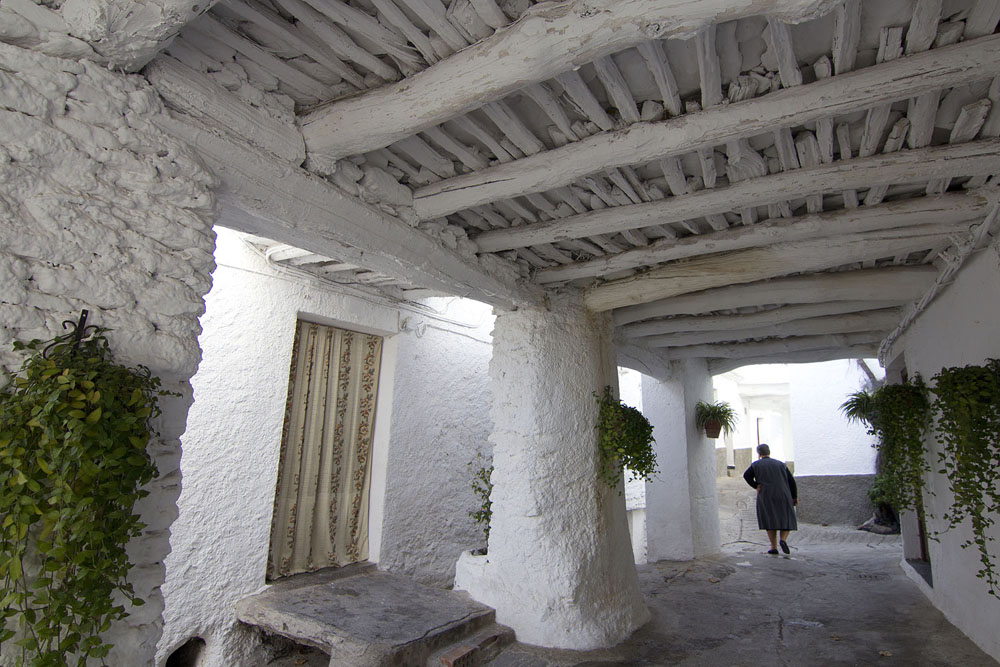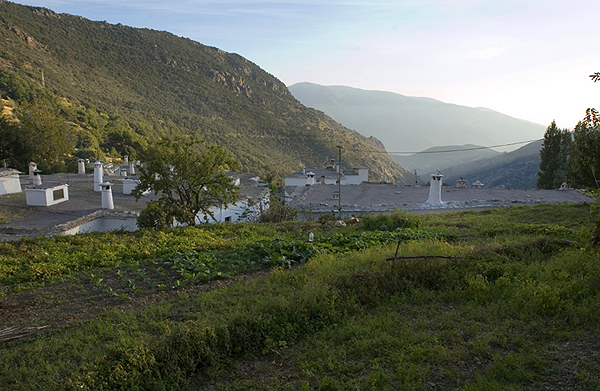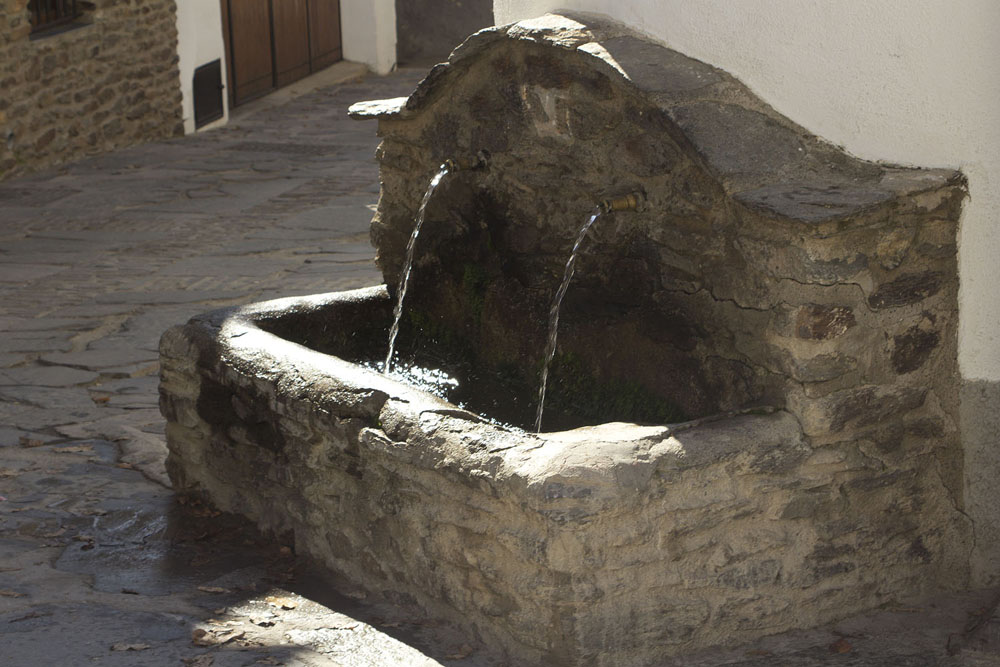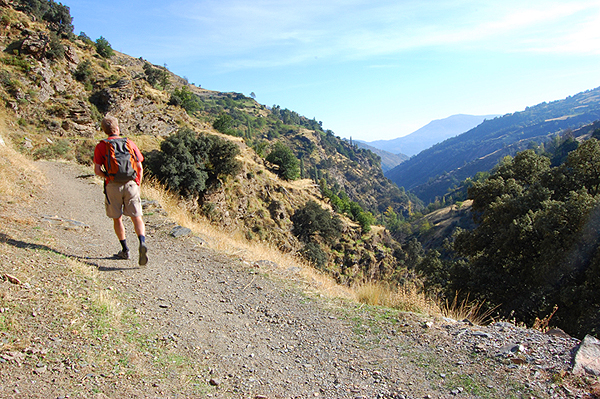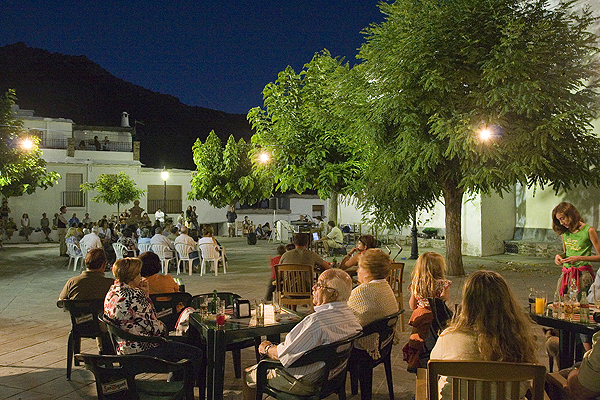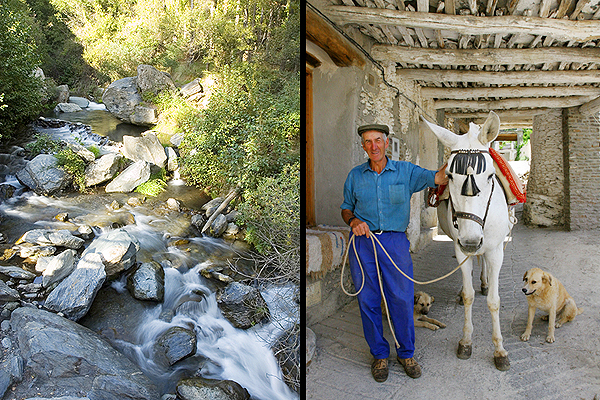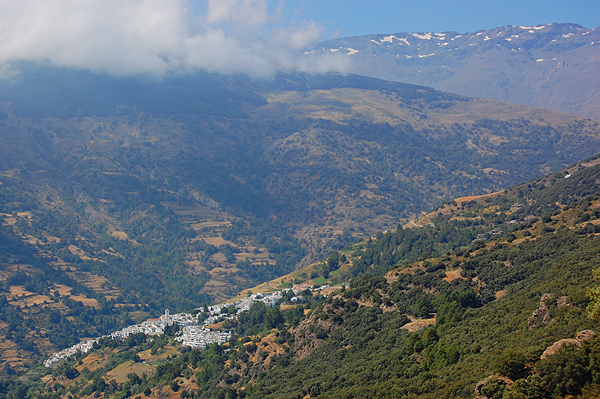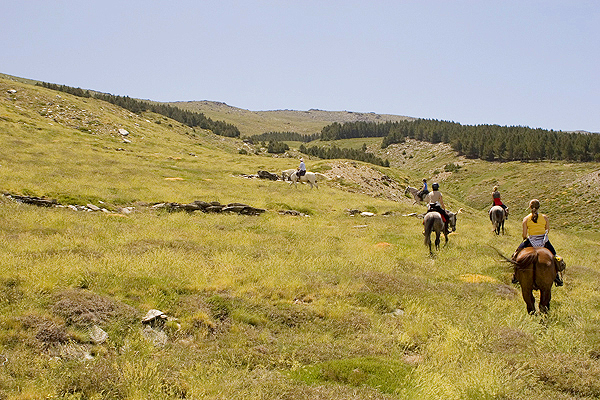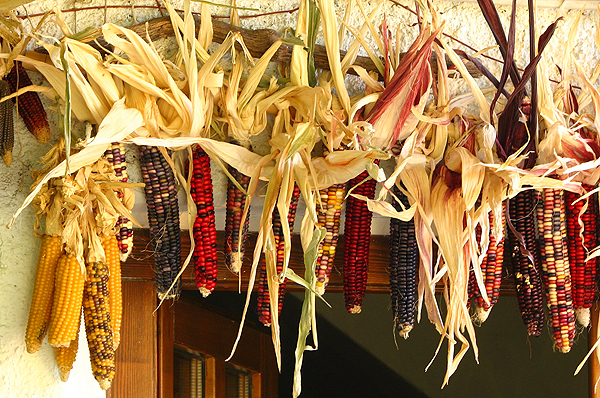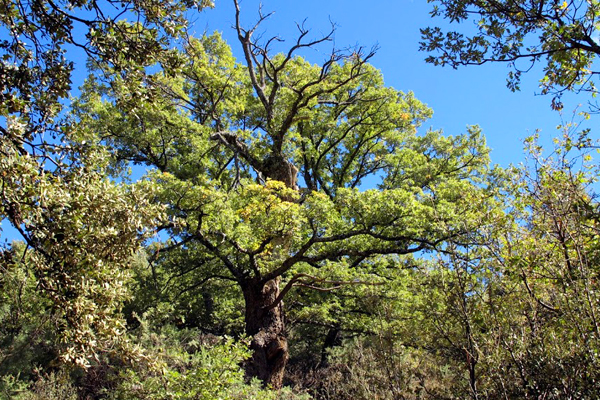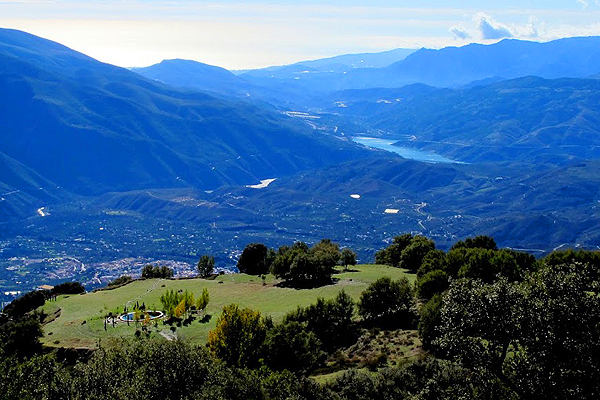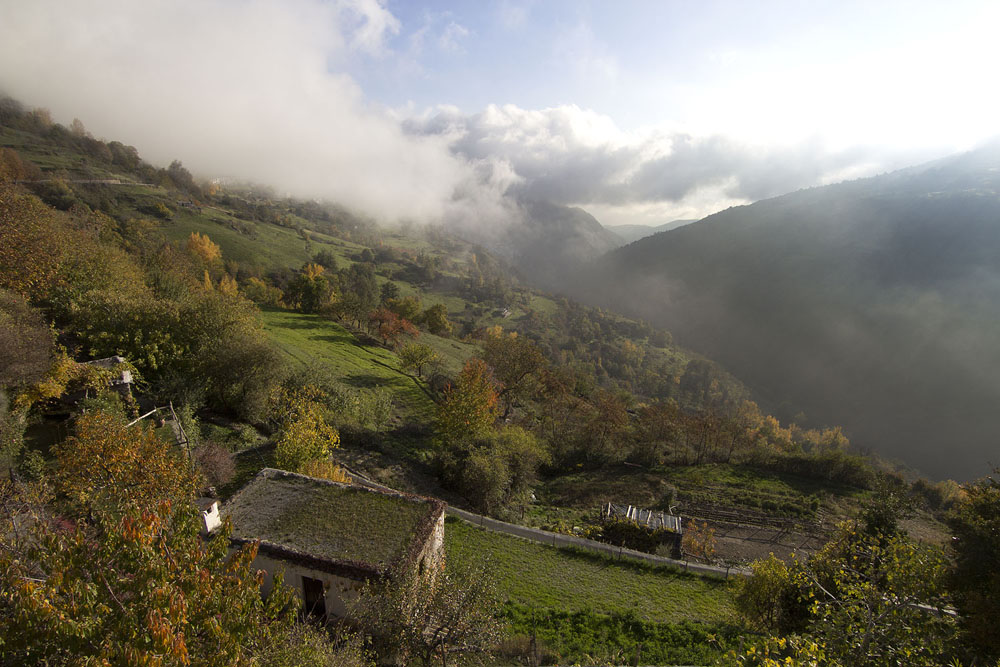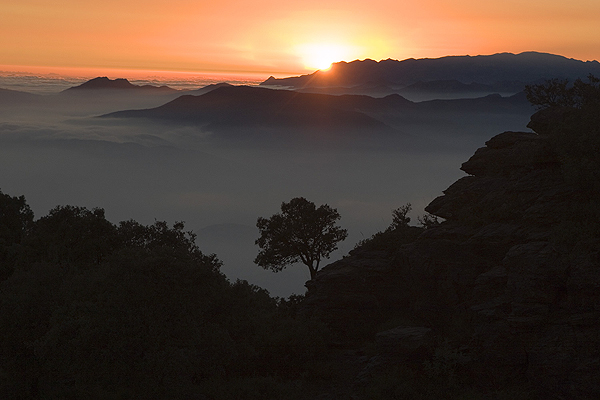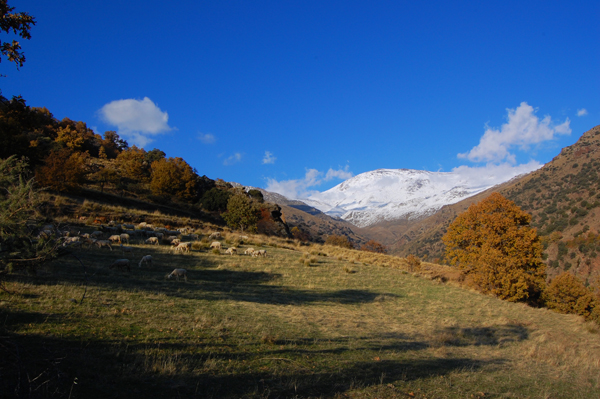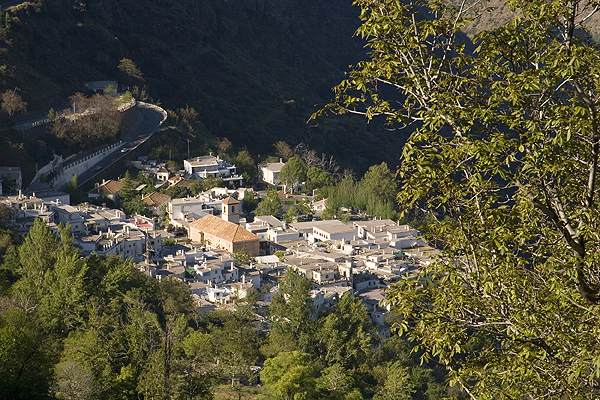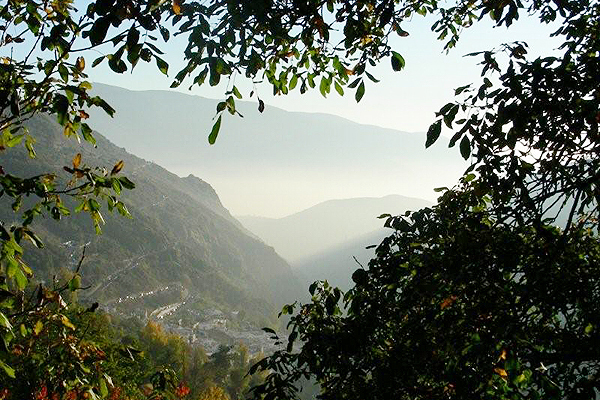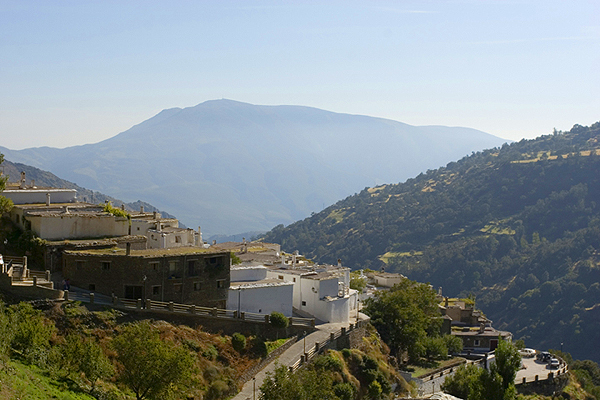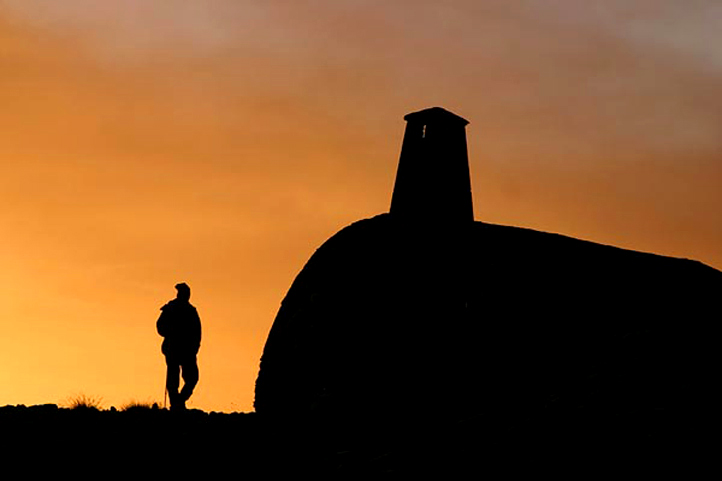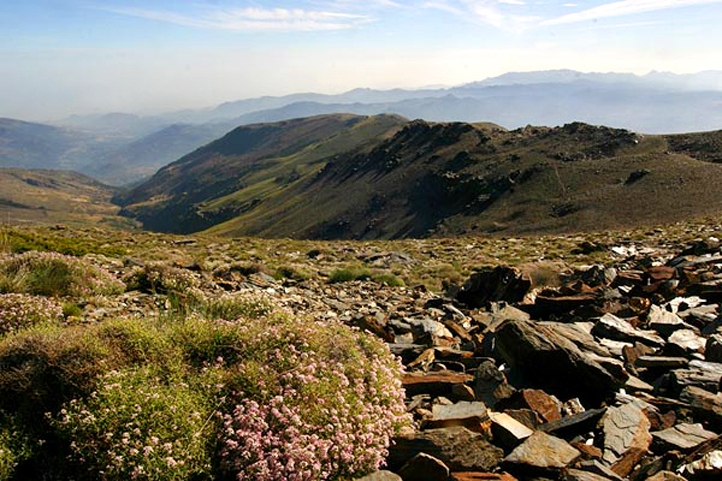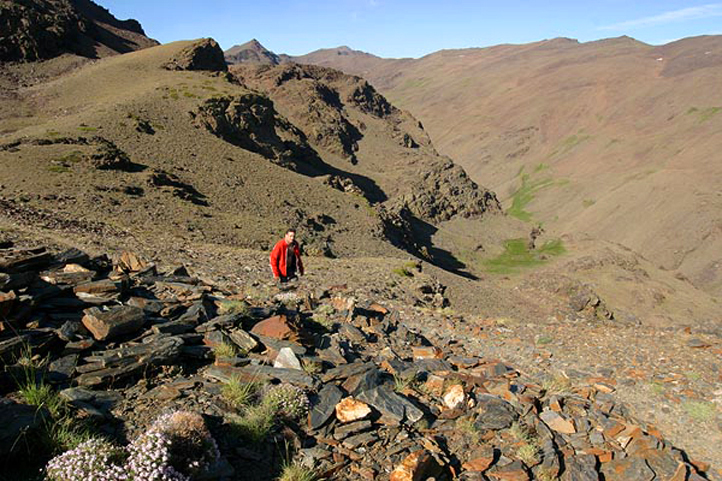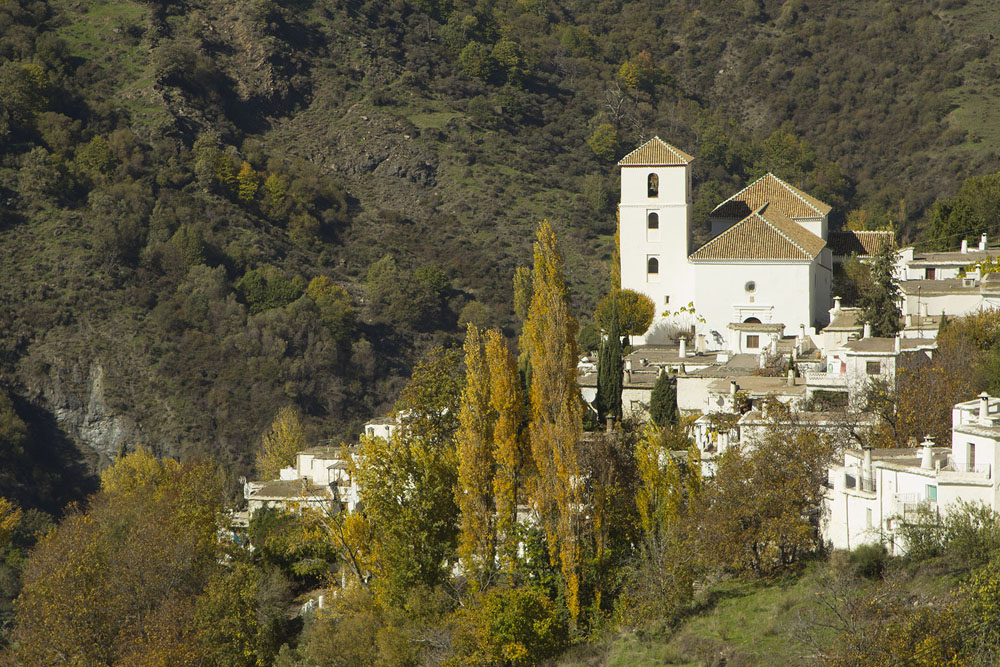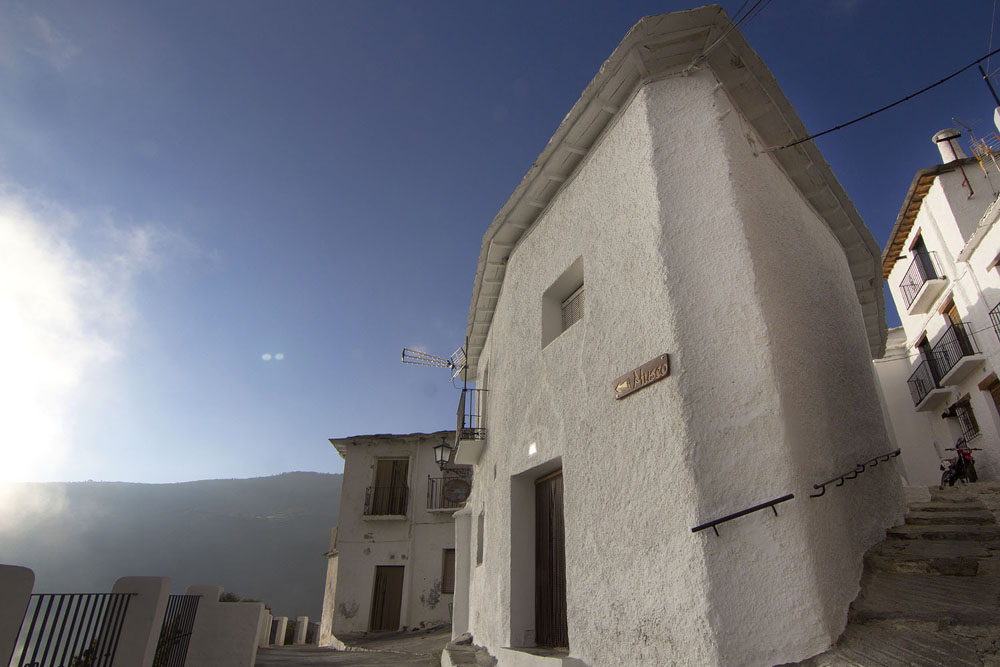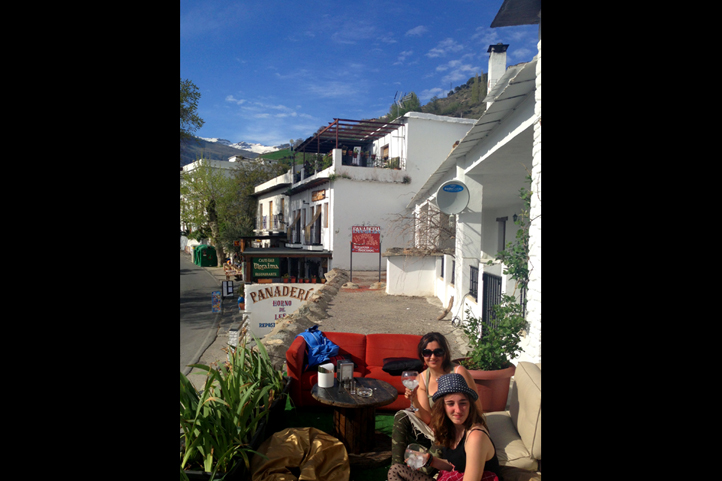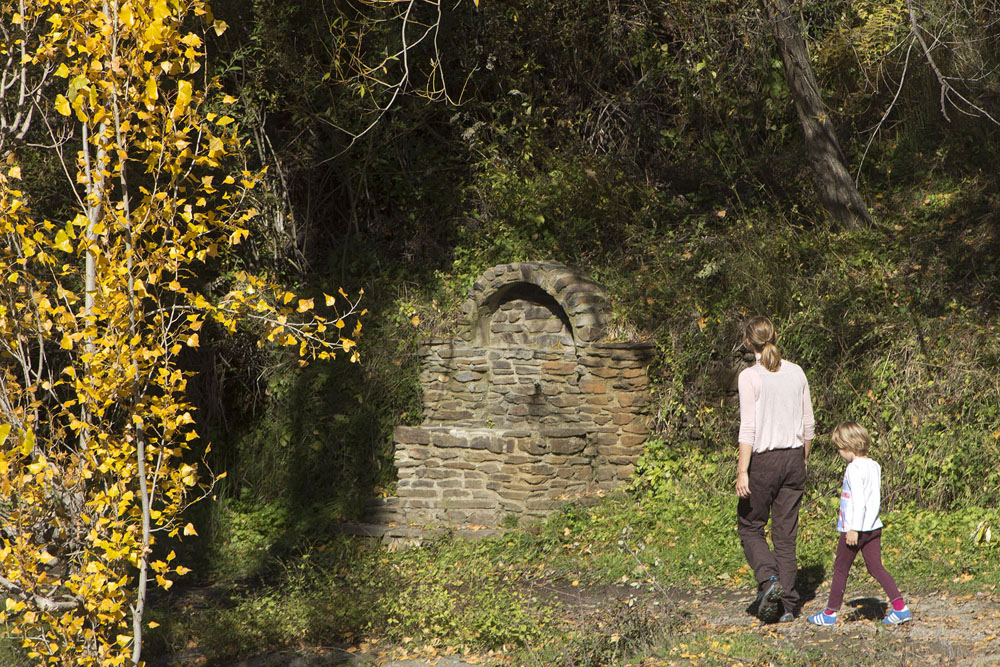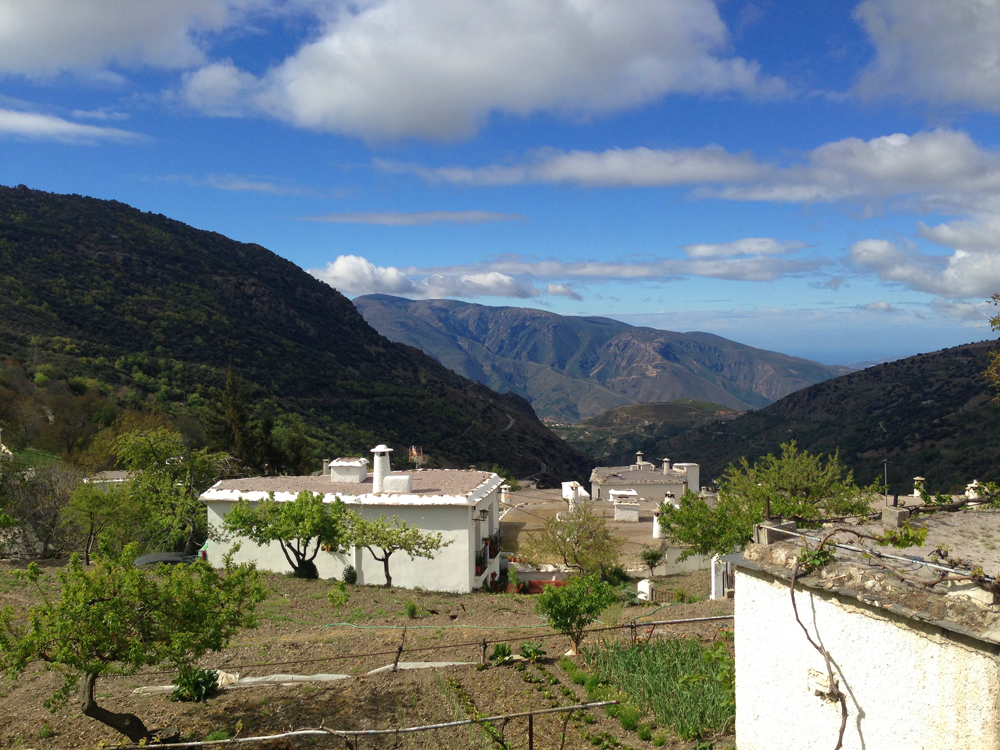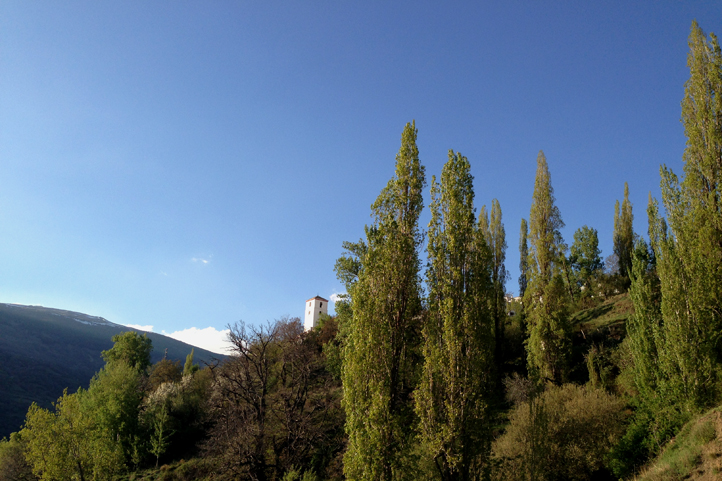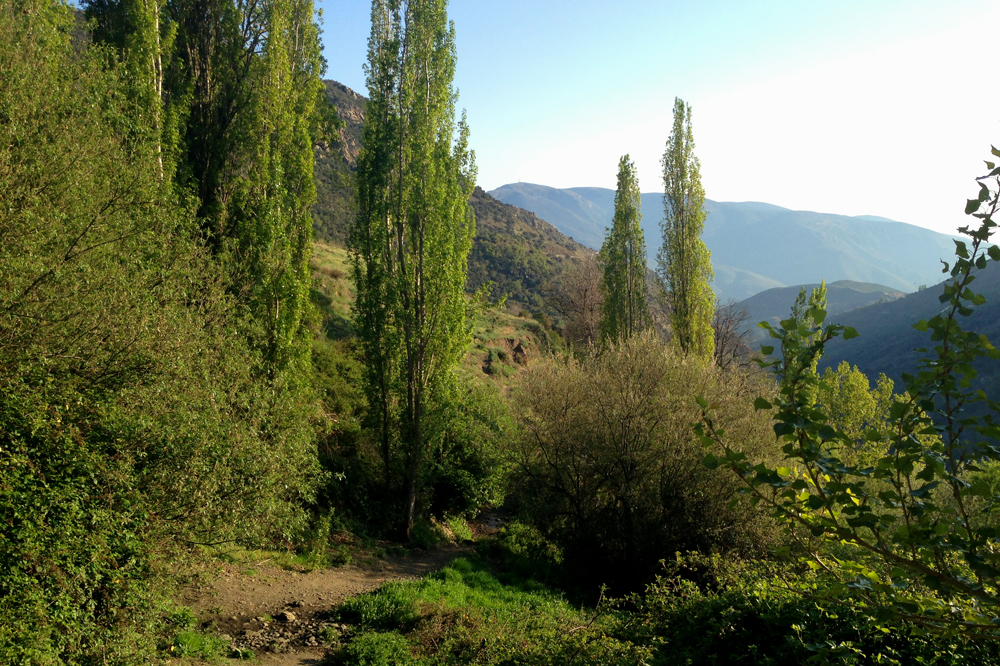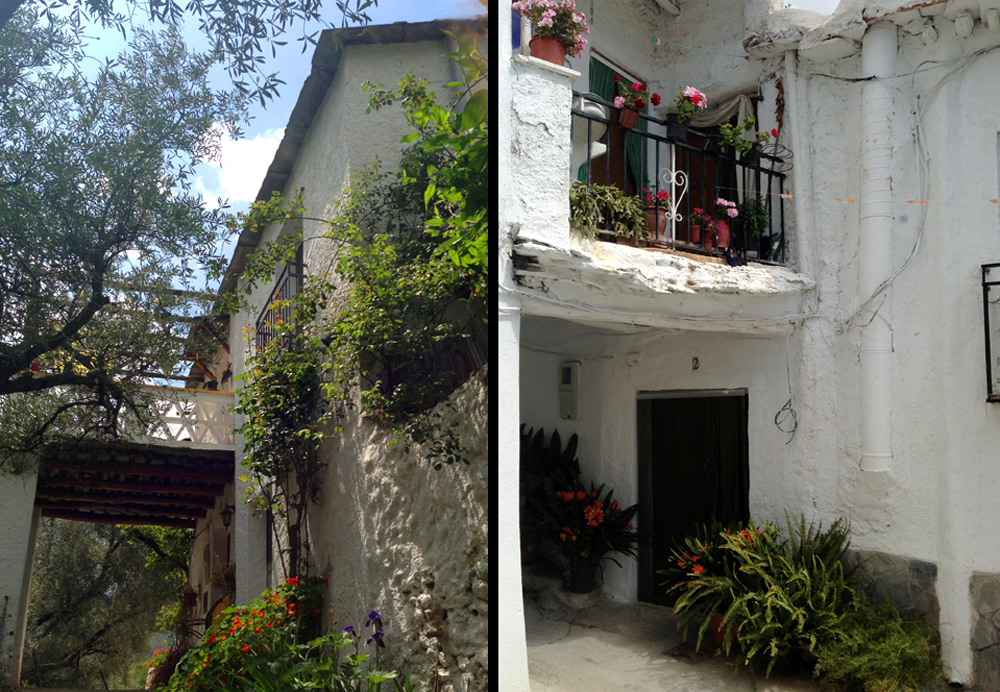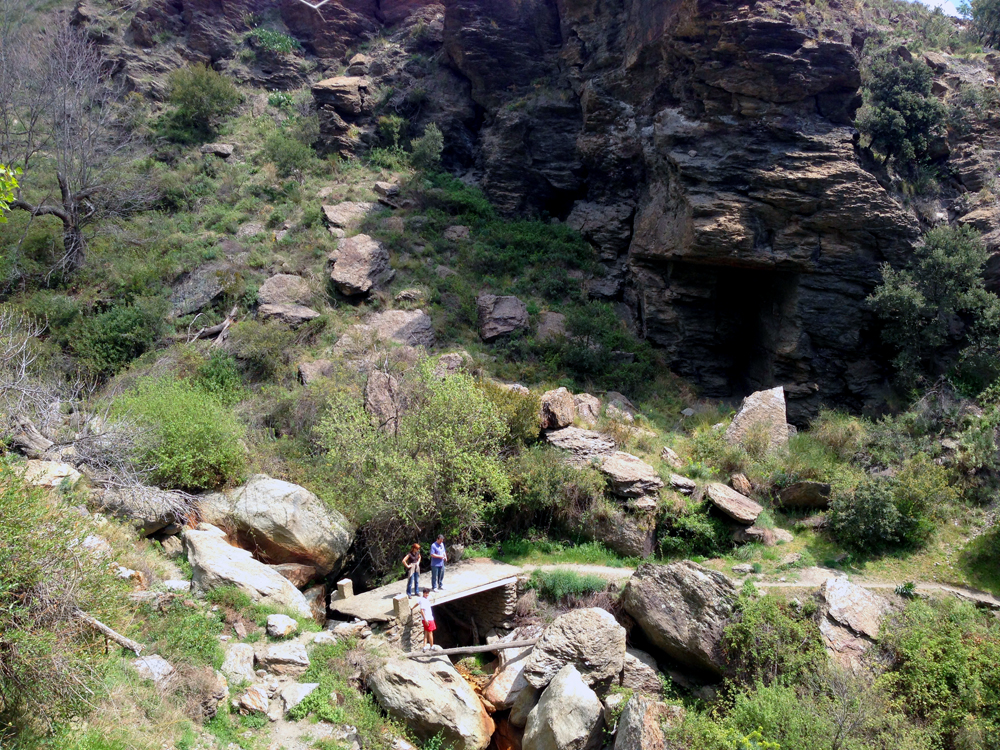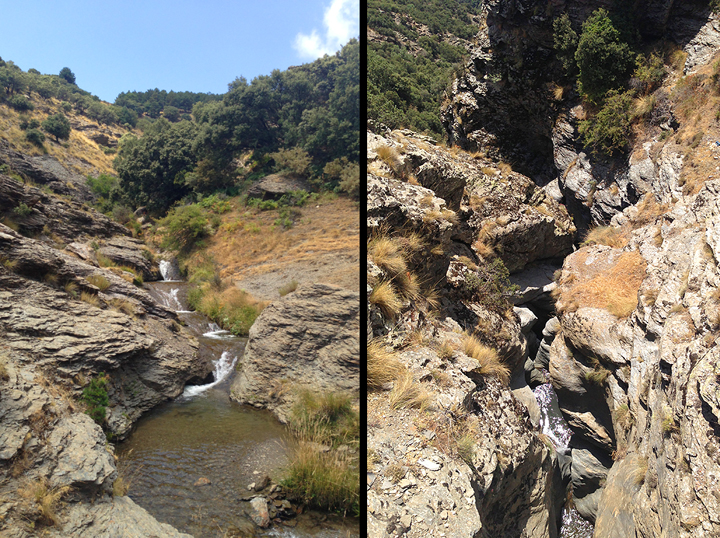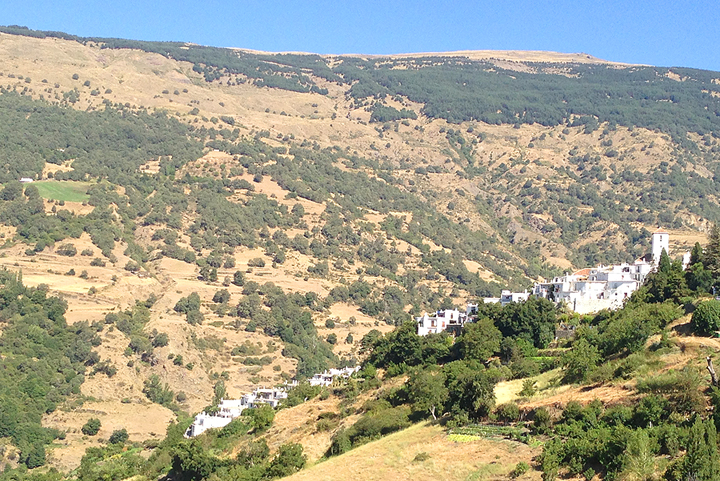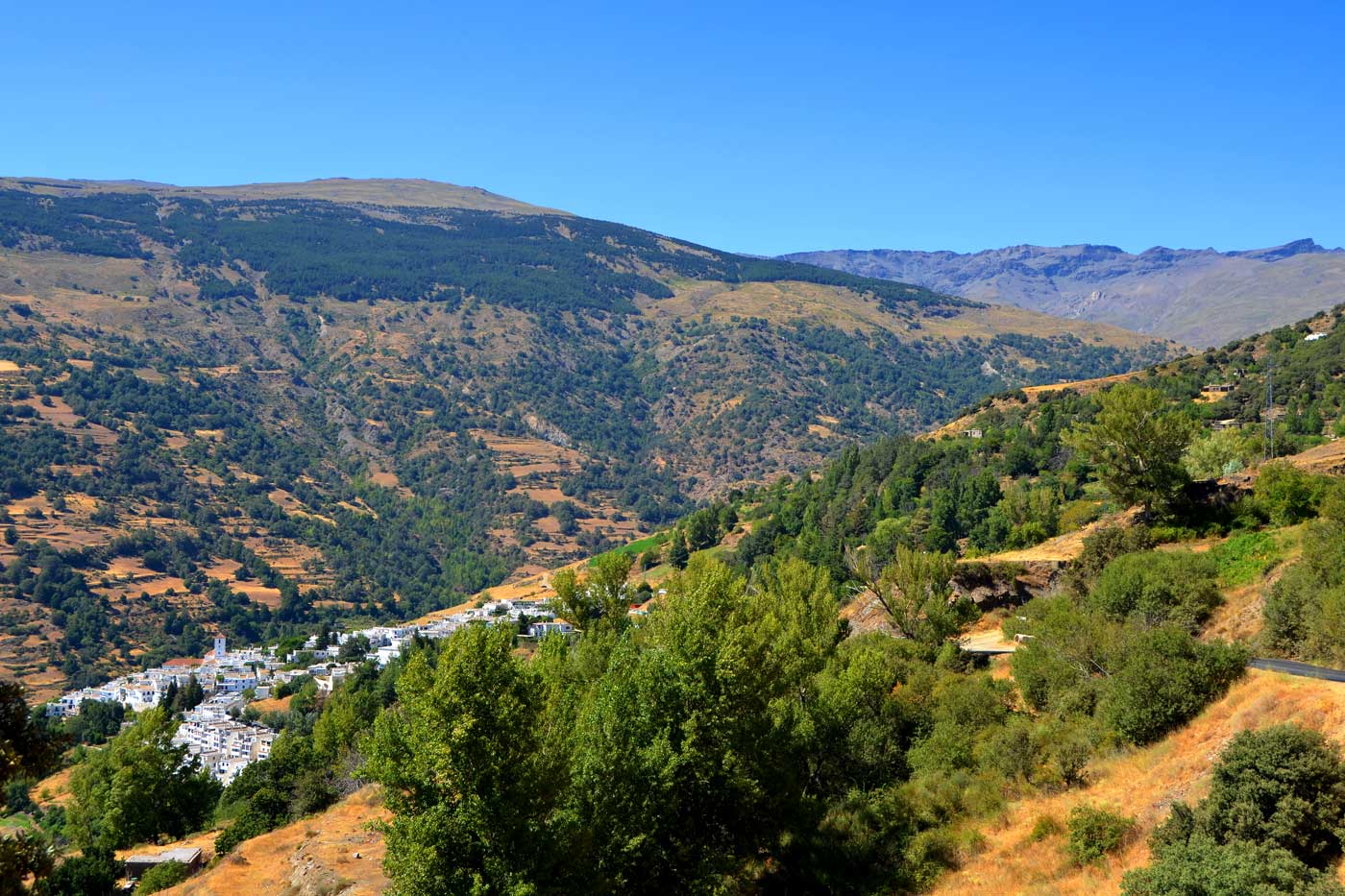The paths, mule tracks and forest trails are an open invitation to everyone to get a real feel for the place and enjoy wonderful mountain countryside and views. There are gentle walks up the gorge, one passing the ghost village of La Cebadilla, built for workers constructing the hydro-electric station where two rivers meet and the path climbs into National Parkland.
Another route takes you through pine forest over the ridge and down into La Tahá, passing through tiny Capilerilla to Pitres, from where it's possible to link up with a bus back to Capileira.
More demanding trails include the trek up Mulhacén (3,482 m), the Iberian Peninsula's highest mountain. Although no rock climbing is involved, the ascent is often impassable in winter as snow can lie deep.
Walking is a year-round activity in the High Alpujarra: the high altitude in the National Park affords cold refreshing air in summer when the villages are taking siestas in the afternoon heat.
Published walking guides and maps are available online (you can use mapsworldwide.com , search for Sierra Nevada) or purchase in local shops, including local petrol stations.
SIERRA NEVADA NATIONAL PARK
Mulhacén crowns Sierra Nevada above the tree line. The terrain is alpine and a source of fascination to botanists who spot unique endemic species that have evolved in an environment of high altitude and Andalusian sun. Herds of ibex roam and eagles fly over head. You can drive up to the entrance of the National Park, park and walk in (there is no charge). In summer a mini-bus goes runs from Capileira all the way into the Park.
Healthy mountains
These days, the pure mountain air and clear, unadulterated spring water gushing from village fountains constitute a reason in themselves for a holiday in the High Alpujarra. It's also a supremely relaxing, easy-going world, with low level tourism and largely empty roads, making it a very healthy choice.
BUBIÓN
Bubión (altitude 1,350 m) is a tranquil village of some 360 inhabitants. The road (there is only one) passes through the top of the village on its way to Capileira, a mile or so further up the ravine. Houses are interspersed with modest shops, bars and a couple of restaurants. After the drive up from Orgiva, you need a few minutes to get your breath back and your bearings, then you realize that you're in reached a privileged spot amidst unbeatable Andalucian mountain scenery, an unhurried (to say the least) place where everyone knows each other and where, "Tranquilo, aquí no pasa nada." ("Relax and take it easy, it's very quiet round here.")
The Visigoths were here, then the Moors, today it's the turn of Spanish mountain country folk and a handful of foreigners who have made their homes here. You will find the oldest houses in the nether parts of the village, down by the undisturbed church square. Some of stone-built houses date back to the 16th century, as does the church, where Christians once took refuge in the tower during the last uprising of the Moors. You can drive down there, but it's quite steep and winding, and more interesting to wander down. It's all very calm.
Along the way, you may pass a tobacconist's or a little restaurant, an old man carrying produce from his vegetable garden or a walker looking forward to a drink and a tapa at the main café-bar-restaurant up top, but that's about it.
Bubión is a perfect place to spend either a restful week or two, on a shady terrace enjoying the view in the summer, in winter with a log fire, or an active holiday, hiking the trails that make the Alpujarra such a magnet for walkers.
From Bubión, footpaths lead down to Pampaneira, up to Capileira, or over the ridge to Pitres and the Taha. If you come by car, your hiking options expand to include high altitude walks through pines and alpine terrain in National Parkland.
Bubión's focal point is a popular café-bar-restaurant with outdoor terraces. There are other bars and restaurants, a simple mini-supermarket, a weaving workshop, two craft shops and a tobacconist's (where you can buy stamps). The local doctor holds surgery for a couple of hours most mornings near the pharmacy.
El Telar is a long-standing weaving workshop run by an enthusiastic French woman who is passionately keen to keep the Andalucian tradition of weaving alive in the Alpujarras. She has two ancient looms from Granada and makes shawls, throws, blankets and bedspreads. She may even provide you with a demonstration of how a loom works, depending on how busy the workshop is.
Hilacar is another weaving shop on the main road. Our tip: alongside the commercially produced jarapas (rugs), Hilacar has hand-made ones, better made and colour-fast, at almost the same price. Look for the label indicating Artesanos de la Alpujarra.
Watch the sunset: Bubión's position in the Poqueira Gorge allows for some great views south-west and across to the sea. It also means some spectacular sunsets. One of the best spots to enjoy this is from the benches by the church, near Rustical Travel cottages in the barrio bajo (lower neighbourhood).
For a sunset walk, if the sky is clear, take a walk from Bubión to the top mountain ridge on the left as you look towards the valley. On the main road, before you reach El Teide bar-restaurant, there is a street on the right that goes up and turns into a track. Follow this track, passing by stables, for about 10 or 15 mins. Look out for a path leading off the main track. Take this path going right and upwards (painted with red-and- white marks: this is the GR-7), and stay on the path until you reach the top (follow parallel white/red lines). From here you can find a good viewing/photo spot and witness an amazing sunset by simply walking over the southern ridge. Duration: 1 hr 30 mins there and back.
CAPILEIRA
An easy 2-km stroll up the road from Bubión, Capileira (population 570) crowns the Poqueira Gorge, where its houses appear to have come to rest after tumbling down in an orderly-disorderly fashion. Its altitude of 1,435 metres makes it the second highest village in Spain. It's somewhat larger than neighbouring Bubión and has more to offer in terms of facilities.
Capileira has several bar-restaurant-cafés with terraces, and a semi-pedestrianized square that acts as a focal point for the village, where children play at sundown while parents and grandparents look on and chat. Around here you'll find café-bars with terraces and WiFi, restaurants, a well-stocked supermarket, craft shops, pharmacy, bank with ATM and the church.
Capileira village is very pretty. The backdrop of the Sierra Nevada is as dramatic as the huge views south down the ravine to Bubión, Pampaneira and to Sierra Lujar, the last mountain before the Mediterranean Sea.
As you wend your way down through the village, the houses get older and the place becomes ever more magical. The winding streets, too narrow for cars, form a fascinating maze of alleys and passages all the way down to where the country path begins its descent to a bridge over the river, joining up with the path to Bubión on the way.
Sometimes it seems to exist in a dream-like state: you wander round and see virtually nobody, met by more dogs and cats than people. Streets and houses are built on top of each other, with typical Alpujarran tinaos (a semi-public porch), curious corners, chicken coops, mule stables and fresh mineral mountain mineral water pouring out of fountains.
There are several good eating and drinking options in Capileira village and a couple of late-night bars, too. It has a butcher's, tobacconist's, craft shops, two bakeries, one with a reputation for the best wood-fired oven loaves.
On Tuesdays, there's a fruit-and-veg market where you can fresh produce direct from the trucks. A doctor's surgery operates most mornings and the local pharmacy is run by a very friendly family.
Among interesting shops are J Brown's leather workshop and store for quality soft leather clothing and bags, and La Alacena local produce shop by the church.
Take an easy walk down to the river or a serious hike up Mulhacén, at 3,142 m the highest mountain on the Iberian Peninsula (Spain and Portugal). Use a guide book and maybe a guide (ask us for contacts) and prepare for a high altitude hike where it is always cold, even at the height of summer when the heat is baking in the village. Wear layers, take water, a hat, and wear sun protection.
LA TAHÁ DE PITRES
Ranged from west to east – unusual for Las Alpujarras – La Tahá (from the old Arabic word for district) is only ten minutes from the Poqueira Gorge yet typically sunnier and a little warmer. The landscape is less dramatic but gentler and the atmosphere is quite bucolic. Facilities are concentrated in Pitres and there are virtually no services in the other six villages.
No fewer than four of the ancient hamlets are at the end of roads which go no further. Paths go out into the countryside and up the valley providing some fabulous hikes. It's perfectly possible to walk round from Mecina to Mecinilla, then down to Fondales, round to Ferreirola and back to Mecina.
Pitres is on the main road (the only road!) through the high Alpujarra. With only 490 inhabitants, it nevertheless dwarves the hamlets for which it acts as the municipal capital.
Pitres is where you will find the Taha's supermarket, bakery, open-air market, bars, a couple of restaurants and bank with ATM. It has a large square dominated by a 16th century Mudejar-style church with a distinctive tower.
WiFi is available at bar-restaurants San Roque and Oveja Verde and other establishments in the village square. Sometimes, the public Guadalinfo centre is open which gives free use of internet on it computers.
The six dependent villages are Capilerilla (not to be confused with Capileira in the Poqueira Gorge), Atalbeitar, Mecina, Mecinilla, Fondales and Ferreirola. These hamlets have populations measured in dozens.
Mecina and Mecininilla have typical Alpujarran country restaurants with terraces.
An easy path leaves Ferreirola and passes by orchards and giant cacti on a route that takes you via a unique fizzy water fountain, under the shade of mature chestnuts, over streams turned red by ferrous minerals, to an area of spectacular views. You stand beneath the ruins of an ancient mosque on a promontory. Up the ravine are the distant Mines of the Oath. The path continues to climb up to Atalbéitar, or Busquístar further along.
Fondales, at the lowest altitude, is able to grow oranges. It's a heavenly little place hidden away at the end of a lane. Bowers of red roses garland streets that wind down to a path continuing to the "Roman" bridge (actually built in the 7th or 8th century) over the River Trevélez. The path joins up with another so that you can loop round to Ferreirola. Like Fondales and Atalbeitar, Ferreirola has no facilities aside from an occasional summer bar, and like both of them it is utterly peaceful. These are settlements that appear to have changed little since Moorish times.
Capilerilla is 1 km above Pitres and can be reached either by road or a footpath which continues up over the wooded hills and down to the Poqueira Gorge. It has no facilities apart from the public bar and restaurant in a mountain hotel that is not always open.
O SEL LIN
Sometimes referred to misleadingly as a "Buddhist monastery," it is a modest Tibetan Buddhist centre and retreat with an interesting stupa and stupendous views. It was inaugurated by the Dalai Lama in 1982. You can drive up almost all the way there. Drive down through Pampaneira, continue five minutes or so to the big curve at Padre Eterno and turn right up the track where horse riding is advertised. Afternoon visits are preferred.
GRANADA
One of Andalucia's great historic, small cities and the site of the magnificent Alhambra Palaces is an hour's drive from the High Alpujarra.
BEACHES
The beaches of Granada's Costa Tropical are just over an hour from the high mountain villages. Don't expect golden sands, but do enjoy fried fish on the beach and a great climate. In our Local Guide for Rustical Travel holidaymakers, we direct you to one of the least known coves with clear water and a good chiringuito beach restaurant.
BEST OF THE REST
Architecture
One of the most characteristic features of the High Alpujarra villages is their unusual architecture. Note the unique flat-roofed design of the houses with their chimneys, a feature going back centuries and originating with the Moorish occupation of Las Alpujarras, who imported the building design of the Berbers in sun-parched northern Africa. As villages descend the natural contours of the hillside, the roofs of the low houses form a patchwork marked out by toadstool chimneys of all shapes and sizes. The flat roofs are now so much a part of the Alpujarran heritage that any new building must follow suit.
Horse riding
Suitable for beginners and experienced riders. Tracks pass through Andalusian mountain countryside, through orange groves and over rivers. Dallas Love's stables just above Capileira have an excellent and deserved reputation.
Biking
Good, well-maintained cross country mountain bikes are available for hire in Capileira. You can book a biking guide to ride the most interesting routes.
River Poqueira
The river through the gorge pools to form impromptu bathing spots. They're not broad enough for swimming, but the cold mountain water will cool off the most overheated hiker.
Art
Capileira is well-known for its artists, including English resident artist, Chris Hoare. The paintings combine local themes with individual styles and visions. You can read about Chris Hoare on our special article Art in La Alpujarra.
Children's park
There's a children's playground in the park below the free car parking at the entrance to Capileira village.
Museum
Capileira has a little museum with typically Andalusian irregular opening hours.
Public swimming pool
Just outside Pitres is a campsite with a large open air swimming pool, surrounded by lawns, that opens to non-campers during the summer months. There's a restaurant here, too.
Pampaneira
The street down from Bubión church turns into a path that meanders down to Pampaneira. It's a nice 20-minute walk downhill, a more challenging 30-minute hike back up again. Huddled into a space at the foot of the gorge where it narrows and the Poqueira River rushes by, Pampaneira is a popular stopping off point for tour buses and the local craft and souvenir shops flourish here. The colourful jarapas (rugs) of the Alpujarra are a little heavy and impractical for flying home with, but there are plenty of other gift ideas if you want to pick something up.
Arts centre
A new centre recently opened in Pitres where you can see and buy interesting and quality paintings, leather work, ceramics and other craftwork. La Casa de Arte is on the road leading up to the village square.
Learn pottery or painting
Available from a very friendly teacher at her studio in Fondales.
Wildlife
The High Alpujarra is home to wild boar, ibex, eagles and other birds of prey, bee-eaters, nightingales and golden orioles.
FIESTAS
In January, the chiscos is one occasion when a village fiesta is meant just for the locals. They gather round bonfires in neighbourhood streets to roast pieces of pork on a date that would have traditionally coincided with the annual matanza, or killing of pigs to make sausages and ham.
The main summer festival in each village with live bands and dancing is celebrated over an August weekend.
The first weekend in November, the mauraca involves more standing round bonfires, this time roasting chestnuts and drinking cups of anis.
FOOD AND DRINK
The mountainous Alpujarra used to be one of Spain's poorest areas. It retains a simplicity in its gastronomy that is amply compensated by plentiful servings that will leave no one unsatisfied.
The culture of tapas is alive and healthy in the High Alpujarra. In the province of Granada, a tapa with your beer or glass of wine comes free. Even a few olives are a welcome accompaniment to a drink and they get better with each refill.
The formidable plato alpujarreño is a fry-up consisting of spicy sausage, egg, black pudding and sliced potato with onion and green pepper. Migas is a filling dish based on fried crumbs and mixed with chopped sausage. Pork is synonymous with "meat" here and features highly on any menu. Vegetarians tend to have a harder time of it, but will be impressed by the giant mixed salads and savour the almond soup, one of the few genuinely autochthonous recipes.
For the sweet tooth, soplillos are the local speciality: almond meringues.
For a sparsely populated area, the High Alpujarra is well provided for in terms of restaurants.
Capileira has three supermarkets. They take it in turn to open Sunday mornings. There are two bakeries (panaderias): one is down the ramp next to the bank and the other, selling more traditional loaves from a wood-fired oven, is on the main road. Also on the main road is a butcher's (carnicería).
Tuesday is market day, when two trucks roll in to sell cheap fresh fruit and vegetables.
For eating out in Capileira, there's plenty of choice:
• La Pizzeria. A pizza restaurant might not sound very Spanish or enticing, but don't be put off by the name. Apart from the advertised dishes, which include wild boar cooked with apple, there is often an interesting dish of the day (plato del día). The pizzas are very good (the local wild oregano may give them their distinctive taste), and are prepared before your eyes by the chef-owner in his open kitchen.
• El Tilo. It is a popular place to meet and have daytime refreshments or lunch on the raised terrace looking over the village square. You can connect to WiFi here.
• Corral del Castaño offers an intimate and relaxed ambience in a large, converted 16th century Alpujarran house, where table are set in different rooms. The chef aims at sophistication with dishes that don't always work, but it's a lovely place for a meal.
• Bar La Tapa has a marvellous selection of wines. It also has WiFi.
• Bar El Atroje. Small inside but with a summer terrace, it's a good place to order a platter of "local mountain-cured ham" (una ración de jamón serrano).
• La Alacena is an authentic little old cellar bar in back of a shop that sells local produce, honey, goat's cheese, almond soap. Just the place to try local costa wine.
• Muy Buenas is open from late until later for those who fancy a bit of high altitude village nightlife.
The culture of tapas is alive and healthy in the High Alpujarra.
Bubión has a simple supermarket and market day for buying fresh fruit and vegetables is Monday.
• Bar-Restaurant El Teide. It is an institution in the Poqueira Gorge. The garden terraces provide an extremely pleasant setting for the generous servings at this typical Alpujarra restaurant. If it's cold out, then the large dining hall inside is a bit impersonal but pleasant enough. We recommend the top class veal sirloin (solomillo de ternera) in black pepper sauce. If you want a really healthy super-juice then ask for a trifásico: an all-in-one apple, carrot and orange juice, only available here. Open from breakfast time onwards. WiFi.
• Estación 4. This restaurant doesn´t have a terrace but it's cozy and has character and they use quality ingredients. Their Calvente red wine from Granada is very good.
• Nómadas. Moroccan-style tea shop, also with WiFi.
In La Tahá, Pitres is your place for shopping, either at the main village supermarket or in the square on Friday market day. It's a simple affair but a chance to pick up cheap fruit & veg, nuts and crafts and maybe have a caña and a tapa on the terrace at the Sierra Nevada bar by the bank.
• Hotel San Roque. It has a pleasant rustic dining room with a log fire in winter and good food. WiFi.
• La Oveja Verde. Choose a table on the terrace for an astonishing view to the south over the valley below and to the Contraviesa mountain range. WiFi.
• Cueva de La Mora Luna. In Mecina, this is one of our favourite spots in La Tahá. Roast meat, salads, home-made pizzas.
• L'Atelier. Also in Mecina, it is a specialist vegetarian and vegan restaurant run by French chef Jean-Claude Juston. Also has a summer terrace.
• El Aljibe. It offers home cooking at a typical Alpujarra country restaurant in Mecinilla. Nicest outside. Tasty mixed salads.
• Hotel de Mecina Fondales. It offers standard Alpujarra fare. Perfectly decent if unexceptional food and it has nice enough places to eat out on the terrace and WiFi.




































